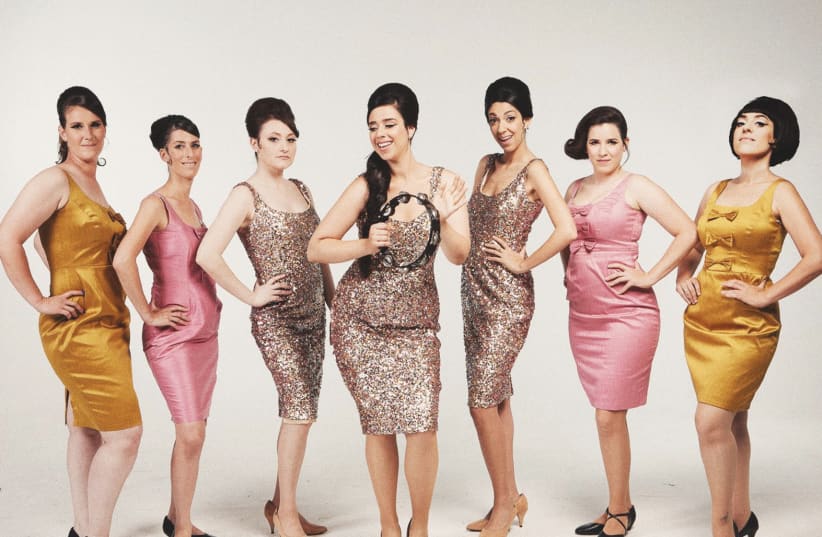Keren Corcos may not be American, let alone African American, but she seems to have some of the requisite sensibilities flowing through her 29- year-old Israeli veins.
Corcos is lead singer, producer and music director of the all-girl Miss Behave septet due to perform at the Tel Aviv Museum of Art on October 14 and 15 (both 7:30 p.m.), as part of the three-day New Orleans Festival (October 14-16). The revue will also be performing Monday night at The Jerusalem Theater. The third edition of the annual run out features a broad offering of musical genres and subgenres, ranging from Miss Behave’s tribute to Motown soul and R&B of the 1960s and 1970s, to gospel and blues, tributes to some of the legendary figures of 20th century jazz, some Latin fare and even an intriguing confluence between the blues and the heady textures and colors of Mizrahi music.
Corcos says she was drawn to the vibes of the music that came out of Detroit – Motown’s home base – and other hits of the day, from the word go. “I grew up with ‘oldies’ at home,” she recalls adding that, in fact, it was a bit of a mixed domestic bag. “My dad would either put on a CD of [Israeli pop-rock band] Ethnix and [Mizrahi music megastar] Eyal Golan – that was the Israeli music I got at home, as a kid,” she laughs, “or it was oldies, stuff from the Sixties and Seventies.”
The lass took in a wide slew of sounds that were generally easy on the ear. Rather than getting into the likes of Led Zeppelin and the Rolling Stones, Corcos cites what she terms “pop songs, you know, more the sweet romantic stuff,” although there is a local connection there too. “My dad had a [box set] collection of six volumes, with the complete soundtrack of Eskimo Limon,” she adds. The latter was a series of Israeli comedy movies which ran from the late Seventies through to 2001 and, initially, achieved unprecedented box office success, here and in Germany. The music that complemented the visual antics was largely early Sixties pop simply reeking of teenage insouciance, with some Fifties rock thrown in for good measure.
As far as Corcos was concerned, that hit the mark. “I have always been drawn to the classics. I remember I found an R&B record lying somewhere. I loved it, particularly American music.”
She and the rest of the Miss Behave gang will do their best to impart that undying love, and unbounded joie de vivre, to their Tel Aviv Museum audience, both sonically and visually. There were quite a few bands out there, back in the day, which featured carefully, and deftly performed, choreographed moves while they sang the number. The likes of The Detroit Spinners, Martha and The Vandellas, and The Supremes – all Motown recording acts – spring to mind.
The latter is a particular role model for Corcos and the group. “[The Supremes lead singer] Diana Ross is the prime source of inspiration for the visual concept [of Miss Behave],” she notes. “Our group logo has three female figures, which is Diana Ross and The Supremes as something that represents Motown, and the whole era when black music made it into mainstream culture.”
Corcos says she and her fellow vocalists put in a shift or two to get all the moves down pat, and make sure they do justice to the original real McCoy. “Replicating the dance moves those bands made is part of the way we approach our own work,” she says, proffering some socio-political insight into the lay of the land back then.
“The goal then was to make the music accessible to white audiences. So they had to pay attention to the aesthetics. They dressed black women in sequined gowns and the black men in tuxedos. It was all set up to be squeaky clean, in contrast with all the stigmas they had in relation to black people.”
That, Corcos believes, spawned the choreography too. “They [white promoters] wanted to create a precise image of the performers, dancing like boy bands or girl bands. It was a carefully devised plan.”
Miss Behave embraced that aesthetic. “We, the three vocalists, worked really hard on getting the exact steps right. I went through all the numbers in turn, and I studied all the moves of the female and male bands, like The Temptations and The Four Tops, and all that style.” Corcos also helped design identical attire for the vocalists. “I worked with a costume design studio, to achieve the exact same dresses. It took a lot of research.”
THE MEMBERS of the Tel Aviv Museum audiences may be forgiven for feeling they could be sitting in some auditorium in 1960s New York, or Los Angeles, as Corcos and her cohorts go through their paces. “We only do covers of original numbers from those days,” she says.
But it is not just about the music. Corcos hopes the public will get some sense of the bygone ambience. “We really try to recreate something like a concert from those days, like we are a Motown band from then.”
That should be appreciated by the over-sixty crowd who, perhaps, got into the music and those soul-fueled vibes at their inception. “We want to reenact something that already exists, and offer a sense of nostalgia to the people who experienced it firsthand, the first time around.”
That is pretty impressive for someone who is not yet out of her twenties. More’s the pity, Corcos feels. “I should have been born in the Sixties,” she laughs. Actually, if she really wanted to catch black American pop music in its cradle she would have been better off making the light of day in the Fifties, like Yours Truly.
However, the fact of the matter is Corcos is a product of her own time, and she says she doesn’t sell out in her quest to achieve “the real thing.” “I don’t try to sound like the original singer. I am who I am, and I bring myself to the music, of course, with the greatest respect for the original.”
Should be fun over at the museum.
For tickets and more information: https://bit.ly/2X9vdsp

